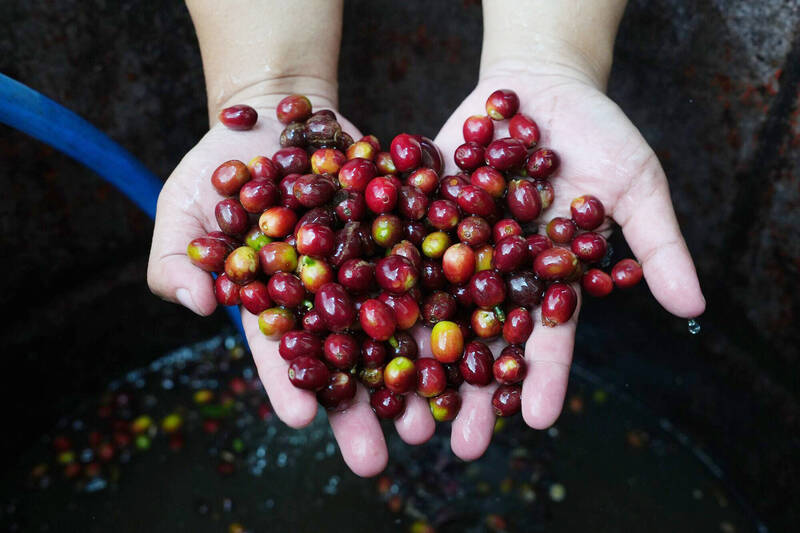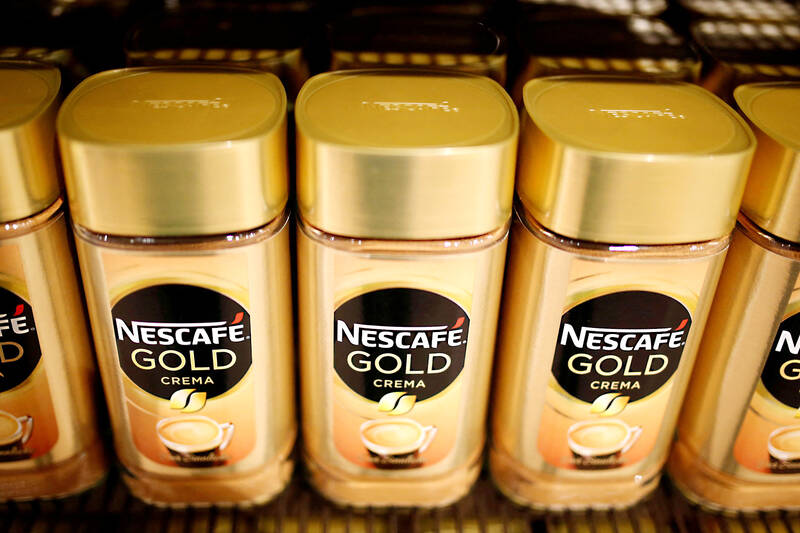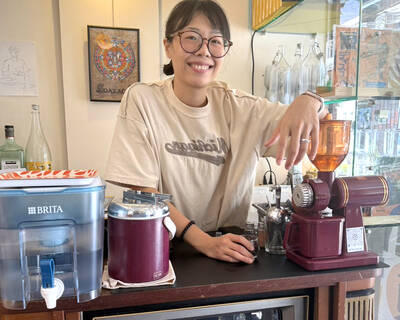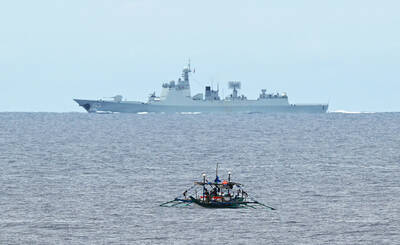Climate change, political headwinds and diverging market dynamics around the world have pushed coffee prices to fresh records, jacking up the cost of your everyday brew or a barista’s signature macchiato.
While the current hot streak may calm down in the coming months, experts and industry insiders expect volatility will remain the watchword, giving little visibility for producers — two-thirds of whom farm parcels of less than one hectare.
METEORIC RISE

Photo: Bloomberg
The price of arabica beans listed in New York surged by 90 percent last year, smashing on Dec. 10 a record dating from 1977 — US$3.48 per pound. Robusta prices have seen similar growth, though prices are lower for the less premium coffee variety.
Fears of poor harvests after droughts in key producers Brazil and Vietnam, respectively the biggest and second-biggest sources of the beans, fueled the price hike.
Demand has outstripped supply for several years now, prompting a flurry of speculative buying that further drove up market prices.

Photo: Reuters
“And then you have the disruption of the Red Sea, which means that from Southeast Asia especially towards Europe it takes much longer, because you need to circumnavigate Africa, and often you have very long delays in the ports,” said Carlos Mera, a coffee analyst at Rabobank.
Traders were also anticipating the implementation of an EU law that would have banned imports of products driving deforestation — though lawmakers recently delayed its coming into force until Dec. 30 this year.
Donald Trump’s threat of punishing trade tariffs on a range of goods adds another level of uncertainty — a top advisor to his predecessor Joe Biden warned in December that food items like coffee would likely be affected.
Nonetheless, given the recent run, “I’m thinking prices are likely or more likely to go lower than higher,” Mera said.
“But it’s a market with very low stock, so we have to expect volatility in either way.”
CLIMATE THREATS
Arabica beans, grown at higher altitudes, are at greater risk from climate change since only a few countries, notably Brazil, could move farms further uphill as the world gets hotter.
Robusta can thrive in a wider range of growing conditions but is less prized by consumers.
In the 2024-2025 growing season around 175 million bags — 60 kilograms each — are expected to be produced, according to the US Department of Agriculture: 56 percent arabica and 44 percent robusta.
Guillaume David at France’s CIRAD agricultural research and international cooperation agency, said both varieties are exposed to new risks in their intertropical growing zones such as late-season frosts, rains at the wrong time and beetle infestations.
“This year we saw these risks in Brazil and Vietnam, whereas before it would be in one or the other,” David said. Brazil grows 40 percent of the world’s coffee, followed by Vietnam (17 percent), Colombia (7 percent), Indonesia (6 percent) and Ethiopia (5 percent). After come Uganda, India, Honduras, Peru and Mexico.
Climate change could make other regions a possibility.
In Africa, Togo or Ivory Coast could again start growing coffee after it was largely replaced by cocoa, or Kenya could replace part of their avocado plantations, David said.
Wherever its grown, experts say growing practices for what is at heart a forest plant need to adapt, with sufficient canopy cover to protect from both sun and storms, and multi-crop farming to protect against pests and diversify revenues.
NEW CUSTOMERS
Demand has expanded beyond the traditional markets of Europe and the Americas to make inroads with tea-drinking Chinese. About 4.3 million bags were imported in the 2023-2024 season, Mera said, up from 1.5 million just four year earlier.
“I would expect China to continue to grow in the future,” he said. “Coffee in the end is addictive, right?
“There is also much more visibility because there are so many more stores and not only in the big cities, but those in like second-tier cities,” he said.
Demand in Europe meanwhile slipped last year, with Germany for example seeing a one percent decrease.
“I think in Europe, the drop in demand was mainly related to the cost of living crisis,” Mera said.
The industry is also keeping an eye on the growing use of weight-loss drugs such as Ozempic, as some doctors caution against drinking caffeine while on the treatment.
SMALL PRODUCERS, BIG PROCESSORS
Despite the recent price surge, millions of growers cultivating coffee on small farms still live in poverty in developing countries. They have little leeway to set prices in a global commodity market dominated by a handful of multinational processors and distributors.
Even fair trade programs to guarantee a living wage affect just five percent of the market — 80 percent of the world’s coffee is bought by heavyweight brokerage firms.
Experts say wild price shifts in recent years make ensuring better prices for growers, many of whom are in developing countries, even more urgent.
A sharp drop in prices could lead growers to abandon their plants, jeopardizing their future revenues, said Nicolas Eberhart of the French food cooperative Ethiquable.
In October, the Group of 7 nations endorsed a Global Coffee Sustainability and Resilience Fund, aimed at spurring private investments to improve productivity and get more money into growers’ pockets.

Cheng Ching-hsiang (鄭青祥) turned a small triangle of concrete jammed between two old shops into a cool little bar called 9dimension. In front of the shop, a steampunk-like structure was welded by himself to serve as a booth where he prepares cocktails. “Yancheng used to be just old people,” he says, “but now young people are coming and creating the New Yancheng.” Around the corner, Yu Hsiu-jao (饒毓琇), opened Tiny Cafe. True to its name, it is the size of a cupboard and serves cold-brewed coffee. “Small shops are so special and have personality,” she says, “people come to Yancheng to find such treasures.” She

In July of 1995, a group of local DJs began posting an event flyer around Taipei. It was cheaply photocopied and nearly all in English, with a hand-drawn map on the back and, on the front, a big red hand print alongside one prominent line of text, “Finally… THE PARTY.” The map led to a remote floodplain in Taipei County (now New Taipei City) just across the Tamsui River from Taipei. The organizers got permission from no one. They just drove up in a blue Taiwanese pickup truck, set up a generator, two speakers, two turntables and a mixer. They

Late last month Philippines Foreign Affairs Secretary Theresa Lazaro told the Philippine Senate that the nation has sufficient funds to evacuate the nearly 170,000 Filipino residents in Taiwan, 84 percent of whom are migrant workers, in the event of war. Agencies have been exploring evacuation scenarios since early this year, she said. She also observed that since the Philippines has only limited ships, the government is consulting security agencies for alternatives. Filipinos are a distant third in overall migrant worker population. Indonesia has over 248,000 workers, followed by roughly 240,000 Vietnamese. It should be noted that there are another 170,000

Hannah Liao (廖宸萱) recalls the harassment she experienced on dating apps, an experience that left her frightened and disgusted. “I’ve tried some voice-based dating apps,” the 30-year-old says. “Right away, some guys would say things like, ‘Wanna talk dirty?’ or ‘Wanna suck my d**k?’” she says. Liao’s story is not unique. Ministry of Health and Welfare statistics show a more than 50 percent rise in sexual assault cases related to online encounters over the past five years. In 2023 alone, women comprised 7,698 of the 9,413 reported victims. Faced with a dating landscape that can feel more predatory than promising, many in